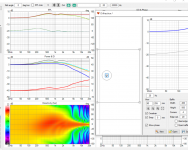Hi all!
I recently complete construction & wiring on my first build. I'm a composer and my future DIY goal is to build a set of wall mounted main monitors, I guess I was drawn to the idea of building them myself for fun, for the challenge, as a learning exercise for my ears, and just as a way to increase my general knowledge peripheral to my field.
My first design is a 3 way sealed speaker, with an MTM configuration of two mid drivers aligned vertically with the tweeter. Construction went as well as you could hope for, a few mistakes here and there, a bit of a rough fit and finish up close but airtight, solid (heavy!) and not fallen apart yet so I must have done okay! I went with a Hypex plate amp for amplification and filters, and I'm glad I did as it's been great to be able to tweak the design as I go even though the cabinets are finished. I'm pretty pleased with the sound so far but am experiencing an imaging issue which I could really use some guidance on, detailed below.
Basically, the monitors I use on a day to day basis have brilliant horizontal imaging, and an absolutely rock solid phantom centre - a well recorded mono voice for example is very convincing and even with my eyes open I can localise it right behind my computer screen. With my speakers, this phantom centre is far less defined, and in fact I almost feel like I'm getting a little bit of treble interference / cancellation between the two speakers in the centre - vocals and drum hits lose a bit of focus & transient detail and some high frequency content seems to vanish. Anything panned to the sides sounds great - maybe even as good as my professional monitors which I'm thrilled about, but anything that comes from the centre just loses that sense of realism. This effect definitely shifts around in frequency based on whether I move my head back and forward, and anytime I move closer to one speaker or the other, it goes away and I get a better balanced (albeit lopsided of course) treble presentation. I guess you could compare it to a tilt shift lens in photography, except one that seems to have an impossibly thin range of focus. Testing them by playing movies, I was struck by a great sense of width and fantastic reproduction of ambience and stereo effects, but dialogue and mono foley sounded muffled and vague. I'm not sure whether I've just somehow managed to design a speaker with incredibly thin horizontal dispersion, or if there's some kind of cancellation issue going on due to a design or construction flaw, etc. I've done a good bit of digging and there's plenty of advice and opinion out there on how a speaker should image, what kind of recordings to play to evaluate it etc, but I've struggled to find a lot of advice on what design elements actually go into getting it right. As I'm still new to this, it's possible that an experienced builder could take one look at my driver arrangement and tell me that I've made a basic mistake that's caused it. So here's a more detailed description of my design and some questions. If anybody has the time to help me with this, it'd be greatly appreciated.
- Cabinet walls are 19mm thick HDF, front baffle is 32mm birch ply (24mm and 12mm glued together), and rear wall is 24mm birch ply. All walls have low expansion foam sheets adhered for mass, and both bass & midrange enclosures are filled with polyester batting. I'd estimate they weigh in around the 45kg-50kg range.
- Bass drivers (10" Seas magnesium cones) are in a 60L sealed enclosure. Front to back and vertical bracing is supplied by the dividing wall for the midrange enclosure, and some horizontal bracing is in place. It's not a great deal considering they are putting out sound at 20hz, but I have to say the bass is actually very satisfactory, certainly to the point where the room is a bigger problem than the speakers. To the touch, they vibrate very little during playback, although the step response measurement I got in my studio shows what looks to be activity up to 40ms on - could this just be the deep bass extension affecting the room or is this telling of a problem?
Midrange drivers (4" Seas magnesium cones) are in a 15L sealed enclosure (more than they need, but I wasn't planning on crossing them over anywhere near their Fs and this allowed me to run a straight wall through the cabinet for bracing while keeping the construction very simple for a first time build). The enclosure wall provides bracing on two axes, but there's no bracing side to side (about 140mm width of enclosure) which I'm starting to wonder about. The tweeter is in this enclosure, and came in its own chamber.
- Working on the crossovers has helped. I originally had 2nd order slopes at 200Hz and 2500Hz, and switching to a 4th order Linkwitz Riley subjectively improved my impression of coherence. I played around with a 6th order filter made of three 2nd orders with a Q of 0.707 each, and liked this, but decided to stick to a well regarded crossover design for now. They're currently at 100Hz and 2000Hz, and even though this is lower than I intended the midrange driver to be playing (especially as the second one is currently not wired in and there's no horizontal bracing in that part of the enclosure) it sounds fine, no noticeable consequence. I suspect there's room for a lot of improvement here, but at the same time, the issues seem to be happening further up in the tweeter's range.
- I've played with toe in, and it absolutely makes a huge difference, but while there's a whole range of better and worse, I have yet to find a position where the sound really 'clicks' into place, and even if I did I'd rather rebuild and achieve stable imaging next time than have to hold my head perfectly still while I'm working. With my ATCs in the same spot in my studio, I can toe them in a lot or barely at all and the imaging is always excellent (they claim an 85 degree horizontal dispersion). My speakers are only a little bit wider, and have a larger baffle roundover. Being so large & heavy, it's no fun at all moving them around and there are only so many positions I can try. I've moved them down to my living room for now, which is larger, and did find that having a bit more distance between me and the speakers made it easier to find an acceptable spot, but even so, as soon as I go back to my monitors, I'm reminded that they're not right yet.
- Although the side walls at the first reflection points are treated well, the ceiling isn't and there's a desk reflection - I know the MTM alignment is supposed to not have much of an effect on horizontal dispersion but I wondered if the extra midrange early reflections arriving at slightly different times were causing the smearing, so I unwired one of the midrange drivers. I left it in which I know is definitely not ideal, but even with the midranges crossed over to the woofer far above the bass range, once the sensitivity change was adjusted for, it made no real difference to anything in the measurements and very little difference to my subjective impression of the problem either.
- I somehow, twice, managed to overestimate the size of the tweeter cutout, so there's maybe 2-4mm of extra space around the edge of the faceplate. Is this enough to cause a diffraction issue that could be the culprit? I have some gasket foam left so as soon as I find that I'll trim it down and fit it into the gap to see if that helps (it's not solid, but should be thick enough for the frequencies we're talking about right?
- My next thought was to time align the drivers at the listening position using measurements. Subjectively I may have liked the effect of this (hard to tell as my ears are still new to this!) but it definitely didn't fix the phantom centre issue. Note that in the living room test REW data I undid this.
- I say the cabinet is airtight, but I should mention that I just drilled holes in the back for the wires to go through to the drivers. The hypex amps use special cables, and I didn't want to seal the gap with glue and have to replace them when I eventually pull the plates out for another project. Now, you do have to push or pull with a bit of force to move the wire, the hole is literally just big enough to squeeze it through, but would this still be a problem?
I guess overall, my suspicion is that a range of issues are adding up to make two speakers that sound good individually but don't image well together, but I'd obviously prefer to have made one or two bigger mistakes that could be rectified. These speakers are prototypes - honestly I may well rebuild them in the near future as a small two way MTM and separate subwoofers for this room so I have more placement options, and in the coming years they'll need to be rebuilt to be mounted in a wall anyway, but I'd love to get them sounding good first time round if it's possible, if for no other reason than to learn for next time.
I couldn't get the zip size down to include my .MDATs but will figure that out later. If anybody has the time to help and would like to get specific measurements to look at, I'd be happy to run them. I guess overall, I'd just really appreciate some pointers on what to measure / change next to try and pinpoint the issue.
Thanks and sorry for the novella!
I recently complete construction & wiring on my first build. I'm a composer and my future DIY goal is to build a set of wall mounted main monitors, I guess I was drawn to the idea of building them myself for fun, for the challenge, as a learning exercise for my ears, and just as a way to increase my general knowledge peripheral to my field.
My first design is a 3 way sealed speaker, with an MTM configuration of two mid drivers aligned vertically with the tweeter. Construction went as well as you could hope for, a few mistakes here and there, a bit of a rough fit and finish up close but airtight, solid (heavy!) and not fallen apart yet so I must have done okay! I went with a Hypex plate amp for amplification and filters, and I'm glad I did as it's been great to be able to tweak the design as I go even though the cabinets are finished. I'm pretty pleased with the sound so far but am experiencing an imaging issue which I could really use some guidance on, detailed below.
Basically, the monitors I use on a day to day basis have brilliant horizontal imaging, and an absolutely rock solid phantom centre - a well recorded mono voice for example is very convincing and even with my eyes open I can localise it right behind my computer screen. With my speakers, this phantom centre is far less defined, and in fact I almost feel like I'm getting a little bit of treble interference / cancellation between the two speakers in the centre - vocals and drum hits lose a bit of focus & transient detail and some high frequency content seems to vanish. Anything panned to the sides sounds great - maybe even as good as my professional monitors which I'm thrilled about, but anything that comes from the centre just loses that sense of realism. This effect definitely shifts around in frequency based on whether I move my head back and forward, and anytime I move closer to one speaker or the other, it goes away and I get a better balanced (albeit lopsided of course) treble presentation. I guess you could compare it to a tilt shift lens in photography, except one that seems to have an impossibly thin range of focus. Testing them by playing movies, I was struck by a great sense of width and fantastic reproduction of ambience and stereo effects, but dialogue and mono foley sounded muffled and vague. I'm not sure whether I've just somehow managed to design a speaker with incredibly thin horizontal dispersion, or if there's some kind of cancellation issue going on due to a design or construction flaw, etc. I've done a good bit of digging and there's plenty of advice and opinion out there on how a speaker should image, what kind of recordings to play to evaluate it etc, but I've struggled to find a lot of advice on what design elements actually go into getting it right. As I'm still new to this, it's possible that an experienced builder could take one look at my driver arrangement and tell me that I've made a basic mistake that's caused it. So here's a more detailed description of my design and some questions. If anybody has the time to help me with this, it'd be greatly appreciated.
- Cabinet walls are 19mm thick HDF, front baffle is 32mm birch ply (24mm and 12mm glued together), and rear wall is 24mm birch ply. All walls have low expansion foam sheets adhered for mass, and both bass & midrange enclosures are filled with polyester batting. I'd estimate they weigh in around the 45kg-50kg range.
- Bass drivers (10" Seas magnesium cones) are in a 60L sealed enclosure. Front to back and vertical bracing is supplied by the dividing wall for the midrange enclosure, and some horizontal bracing is in place. It's not a great deal considering they are putting out sound at 20hz, but I have to say the bass is actually very satisfactory, certainly to the point where the room is a bigger problem than the speakers. To the touch, they vibrate very little during playback, although the step response measurement I got in my studio shows what looks to be activity up to 40ms on - could this just be the deep bass extension affecting the room or is this telling of a problem?
Midrange drivers (4" Seas magnesium cones) are in a 15L sealed enclosure (more than they need, but I wasn't planning on crossing them over anywhere near their Fs and this allowed me to run a straight wall through the cabinet for bracing while keeping the construction very simple for a first time build). The enclosure wall provides bracing on two axes, but there's no bracing side to side (about 140mm width of enclosure) which I'm starting to wonder about. The tweeter is in this enclosure, and came in its own chamber.
- Working on the crossovers has helped. I originally had 2nd order slopes at 200Hz and 2500Hz, and switching to a 4th order Linkwitz Riley subjectively improved my impression of coherence. I played around with a 6th order filter made of three 2nd orders with a Q of 0.707 each, and liked this, but decided to stick to a well regarded crossover design for now. They're currently at 100Hz and 2000Hz, and even though this is lower than I intended the midrange driver to be playing (especially as the second one is currently not wired in and there's no horizontal bracing in that part of the enclosure) it sounds fine, no noticeable consequence. I suspect there's room for a lot of improvement here, but at the same time, the issues seem to be happening further up in the tweeter's range.
- I've played with toe in, and it absolutely makes a huge difference, but while there's a whole range of better and worse, I have yet to find a position where the sound really 'clicks' into place, and even if I did I'd rather rebuild and achieve stable imaging next time than have to hold my head perfectly still while I'm working. With my ATCs in the same spot in my studio, I can toe them in a lot or barely at all and the imaging is always excellent (they claim an 85 degree horizontal dispersion). My speakers are only a little bit wider, and have a larger baffle roundover. Being so large & heavy, it's no fun at all moving them around and there are only so many positions I can try. I've moved them down to my living room for now, which is larger, and did find that having a bit more distance between me and the speakers made it easier to find an acceptable spot, but even so, as soon as I go back to my monitors, I'm reminded that they're not right yet.
- Although the side walls at the first reflection points are treated well, the ceiling isn't and there's a desk reflection - I know the MTM alignment is supposed to not have much of an effect on horizontal dispersion but I wondered if the extra midrange early reflections arriving at slightly different times were causing the smearing, so I unwired one of the midrange drivers. I left it in which I know is definitely not ideal, but even with the midranges crossed over to the woofer far above the bass range, once the sensitivity change was adjusted for, it made no real difference to anything in the measurements and very little difference to my subjective impression of the problem either.
- I somehow, twice, managed to overestimate the size of the tweeter cutout, so there's maybe 2-4mm of extra space around the edge of the faceplate. Is this enough to cause a diffraction issue that could be the culprit? I have some gasket foam left so as soon as I find that I'll trim it down and fit it into the gap to see if that helps (it's not solid, but should be thick enough for the frequencies we're talking about right?
- My next thought was to time align the drivers at the listening position using measurements. Subjectively I may have liked the effect of this (hard to tell as my ears are still new to this!) but it definitely didn't fix the phantom centre issue. Note that in the living room test REW data I undid this.
- I say the cabinet is airtight, but I should mention that I just drilled holes in the back for the wires to go through to the drivers. The hypex amps use special cables, and I didn't want to seal the gap with glue and have to replace them when I eventually pull the plates out for another project. Now, you do have to push or pull with a bit of force to move the wire, the hole is literally just big enough to squeeze it through, but would this still be a problem?
I guess overall, my suspicion is that a range of issues are adding up to make two speakers that sound good individually but don't image well together, but I'd obviously prefer to have made one or two bigger mistakes that could be rectified. These speakers are prototypes - honestly I may well rebuild them in the near future as a small two way MTM and separate subwoofers for this room so I have more placement options, and in the coming years they'll need to be rebuilt to be mounted in a wall anyway, but I'd love to get them sounding good first time round if it's possible, if for no other reason than to learn for next time.
I couldn't get the zip size down to include my .MDATs but will figure that out later. If anybody has the time to help and would like to get specific measurements to look at, I'd be happy to run them. I guess overall, I'd just really appreciate some pointers on what to measure / change next to try and pinpoint the issue.
Thanks and sorry for the novella!
Attachments
-
 DIY Orange vs Genelecs Blue.jpg748.5 KB · Views: 123
DIY Orange vs Genelecs Blue.jpg748.5 KB · Views: 123 -
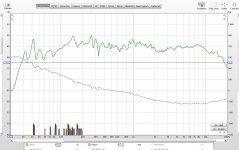 Freq Response Phase.jpg519.3 KB · Views: 120
Freq Response Phase.jpg519.3 KB · Views: 120 -
 IMG_2986.jpg981.4 KB · Views: 115
IMG_2986.jpg981.4 KB · Views: 115 -
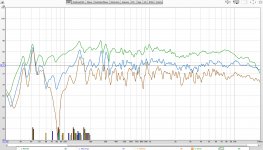 Living Room 30cm-60cm-120cm.jpg760.8 KB · Views: 119
Living Room 30cm-60cm-120cm.jpg760.8 KB · Views: 119 -
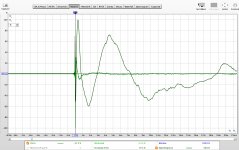 Step Response 20ms.jpg479.9 KB · Views: 122
Step Response 20ms.jpg479.9 KB · Views: 122 -
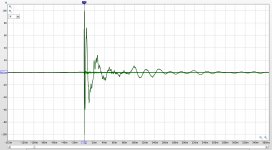 Step Response 400ms.jpg359.8 KB · Views: 55
Step Response 400ms.jpg359.8 KB · Views: 55 -
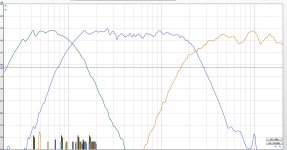 Woof-Mid-Tweet.jpg310.7 KB · Views: 60
Woof-Mid-Tweet.jpg310.7 KB · Views: 60
Hi Leeken, nice looking speakers! Can you make quasi-anechoic measurements, aka home spinorama? Full view on the speaker response all around could reveal problems, could be with crossover or diffraction or something else. You can do measurements with REW and visualize the data in VituixCAD. Measurement help documents top of the page here: VituixCAD Loudspeaker simulator
I suspect there is still diffraction problems due to large baffle. Distance from the mids to the opposide side edge makes over 1ms of delay. Quick diffraction tool simulation shows all kinds of interference due to diffraction but I suspect the delay there it what makes the image smear. You get the direct sound, and then a smeared copy following it and the smear/timing depends mostly on the baffle edge distance from each driver. Much bigger roundovers or tiny baffle would help with this.
Does your other monitor (ATC?) have such big distances on the baffle?
Attached is quick guestimate diffraction tool sim, the "smear" shows in the polar map around ~500-3kHz, tweeter would have this as well, higher in frequency.
I suspect there is still diffraction problems due to large baffle. Distance from the mids to the opposide side edge makes over 1ms of delay. Quick diffraction tool simulation shows all kinds of interference due to diffraction but I suspect the delay there it what makes the image smear. You get the direct sound, and then a smeared copy following it and the smear/timing depends mostly on the baffle edge distance from each driver. Much bigger roundovers or tiny baffle would help with this.
Does your other monitor (ATC?) have such big distances on the baffle?
Attached is quick guestimate diffraction tool sim, the "smear" shows in the polar map around ~500-3kHz, tweeter would have this as well, higher in frequency.
Attachments
I would do a simple experiment that switches the right speaker for the left speaker to see if the phantom center image changes. that would point to edge diffraction
When ever I have had a wandering or poor center image, it was because I had a driver connected inverted phase. (from what it should be). I am always double and triple checking phase. Especially in active crossover speakers.
When ever I have had a wandering or poor center image, it was because I had a driver connected inverted phase. (from what it should be). I am always double and triple checking phase. Especially in active crossover speakers.
Thank you both for the input! Signal Lost, do you mean swapping left and right output or moving the physical speakers? Tmuikku, I will have a go at the spinorama! Might take a while to find a good day to do it, but will give it a go when I get a chance. I also found out that with one of the speakers, the midrange enclosure isn't fully airtight, I didn't spot it before but when I push the woofer the midrange cones move ever so slightly, and I can feel them vibrating when I only drive the woofer and play a 20hz tone... Perhaps this is contributing. Will seal it up and see!
I'm definitely not ruling out baffle diffraction and obviously want to eliminate it as much as possible either way, but to be clear both speakers sound good on their own, it's when you listen from the sweet spot between them that things get weird.
I'm definitely not ruling out baffle diffraction and obviously want to eliminate it as much as possible either way, but to be clear both speakers sound good on their own, it's when you listen from the sweet spot between them that things get weird.
I believe both speakers must have identical response curves for a good center image, if deviation is too large then center image will suffer, i also believe there might be some speaker placement issues like bad reflexions
What is the step response attachment showing? Is blue one channel's step response and red the other channel's? If so it is apparent that the both tweeters start off with positive acoustic polarity, but when the mids (or bass) catch up, in one speaker the driver polarity is the same as the tweeter, in the other it is reversed compared to the tweeter. That will stuff up the imaging big time.
The correct polarity of the drivers relative to each other in a system is generally that which gives the flattest amplitude response across the crossover frequency. But whatever the design criteria is, both channels need to be the same.
The correct polarity of the drivers relative to each other in a system is generally that which gives the flattest amplitude response across the crossover frequency. But whatever the design criteria is, both channels need to be the same.
I'm not sure what the green impulse response is showing, but there is an awfully long sinusoidal persistence (AKA high Q resonance) with a period of approximately 12mS (~83Hz) apparent in the second plot.
Edit: not being familiar with the software I may be misinterpreting the horizontal scale. The Excel magnesium drivers have a series of exceptionally high Q cone breakups in the 7k - 20kHz range; maybe this is one of them.
Edit: not being familiar with the software I may be misinterpreting the horizontal scale. The Excel magnesium drivers have a series of exceptionally high Q cone breakups in the 7k - 20kHz range; maybe this is one of them.
Last edited:
Greets!
From just looking at the pics........ [coffee] tables, etc., make great 'floor bounce' reflectors that can ruin a phantom center, so try either covering it up with a heavy blanket or move it well away from the 'sweet spot'.
Tweeters at ear height or aimed up/down as required? Toe'd in to cross at some point in front of your face? All these issues have proven to be essential for a solid phantom center IME.
From just looking at the pics........ [coffee] tables, etc., make great 'floor bounce' reflectors that can ruin a phantom center, so try either covering it up with a heavy blanket or move it well away from the 'sweet spot'.
Tweeters at ear height or aimed up/down as required? Toe'd in to cross at some point in front of your face? All these issues have proven to be essential for a solid phantom center IME.
- Home
- Loudspeakers
- Multi-Way
- First build phantom centre problem
